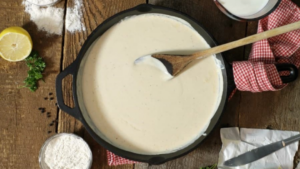Sauces are the splendor and glory of French cooking, yet there is nothing serious
or mysterious about making them. These are indispensable to the home cook.
– Julia Child, Mastering the Art of French Cooking
I’ve been known to question whether certain foods or culinary items need the full day, week, or month set aside to commemorate them – March is, for example, Celery Month and I think we can all agree this is overkill. But March is also Sauce Month and sauce (as a concept and a culinary category not to mention the vast array of individual sauces) is not only a topic that would easily take a month to cover; it’s a topic that deserves it. A quick primer to make my point.


The five sauces are:
- Sauce Béchamel (white): milk-based sauces, thickened with a light or white roux. If you’re making white sauce for lasagna, this is it. Think cream or mustard sauces. Think Mornay sauce … hmmmmm
- Sauce Espagnole (brown): sauces using veal or beef stock, also called darker or roasted stocks. These can be further reduced to demi-glaces. Think Madeira sauce, Lyonnaise sauce, mushroom sauces.
- Sauce Velouté (blonde) sauces based on lighter stocks (chicken or fish), thickened with a roux or a mixture of egg yolks and cream, often with a dash of lemon juice. Think white wine sauces based on fish veloute or the Suprême sauce on chicken.
- Sauce Hollandaise (butter)*: a sauce comprise of egg yolk and butter, emulsified and then with lemon or vinegar to taste. Think Béarnaise. Think Eggs Benedict. Think mayonnaise. Speaking of which, go read The Myths and Making of Mayonnaise. It’s really one of my best – a very informative post not only on the history of mayo but on variations to try. Anyone for Mayo week?

- Sauce Tomate (red): a tomato-based sauce, just what it says on the tin but don’t think it’s just your basic Italian pasta sauce. No, think Provençale sauce, Creole sauce. It’s a far spicier and more interesting category than you think.
Using these as a starting point, you can get to anything from Bolognese to mayonnaise to roux. And Julia is right (as she so often was) – they aren’t mysterious or difficult. They can be fiddly, yes. But so is finding your car keys on occasion. Brain surgery is difficult. Sauce is sauce.
If you want to shake up Sauce month with something a bit spicier, why not try a classic Mexican mole sauce. You might have heard mole described as a chocolate sauce – which is both accurate and misleading. While there are quite a variety of mole sauces, the most well-known is called mole poblano – a sauce involving over 20 different ingredients – and it uses a bit of chocolate to counteract the heat of the many types of chilies, peppers and spices that make up the bulk of the sauce.
You can keep globe-trotting to Southeast Asia and Asia by trying out some curry or miso-based sauces. You can try a different sauce every day of Sauce month without fear of running out of options so, get in the kitchen and get saucy!

1 thought on “The Saucy Month of March”